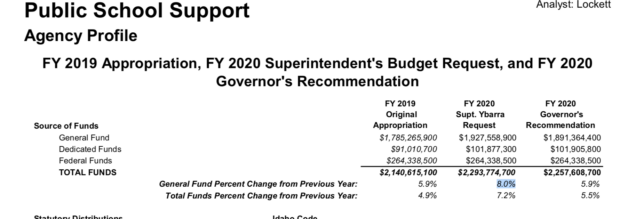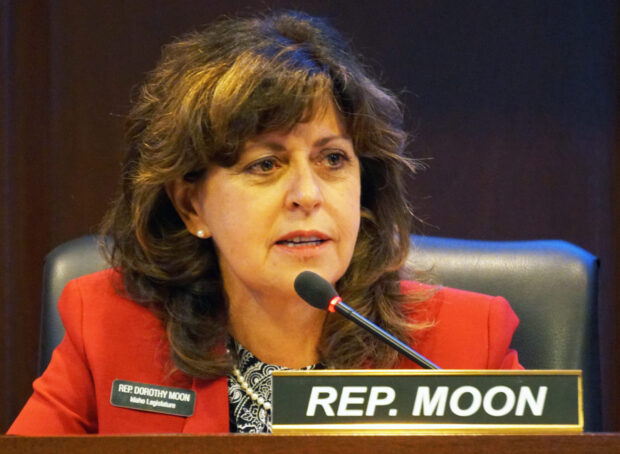Schools chief Sherri Ybarra continued to pitch her public school budget request and school safety proposal Monday, briefing the House Education Committee on her plans.
The presentation largely mirrored her closely-watched hearing before the Joint Finance-Appropriations Committee Thursday. Ybarra reiterated her call to increase state general fund spending by investing in teacher salaries.
Confusingly, Ybarra told legislators she is seeking a 6.8 percent increase for 2020.

Actually, based on the 2019 funding levels lawmakers have already approved, Ybarra is seeking an 8 percent increase.
Her 2020 request would amount to a 6.8 percent increase only if JFAC re-opened the 2019 budget and added her $19.1 million supplemental funding request for her Keep Idaho Students Safe proposal. The prospects for this school safety plan appear thin — Gov. Brad Little did not recommend funding KISS. On top of that, state revenues have come in millions of dollars below projections and several JFAC members have said they don’t see KISS moving forward at this time.
Some of Ybarra’s top budget priorities include:
- $48 million in new funding to pay for the fifth year of educator raises under the career ladder salary law.
- $27.8 million in additional funds for raises above and beyond the career ladder.
- $11.9 million for master educator premiums, salary incentives designed to reward Idaho’s most experienced and accomplished educators.
- $14.8 million in new funding for discretionary funding for school districts. About half of that total would go toward health insurance costs.
Then, Ybarra and Safe and Drug Free Schools director Matt McCarter briefed House Education on her KISS proposal. The presentation basically amounted to the first legislative hearing on her proposal since Ybarra announced it on March 12, 2018.
Ybarra wants $18.5 million in supplemental funding in 2019 for school safety and security grants for each school and $410,000 in supplemental funding for school safety courses for educators and staff.
“As I travel the state, school safety has been a top concern and priority and, as a mother of a high school senior this year, it is no different for me,” Ybarra told legislators.
After the presentations, legislators asked only a couple of questions.
- Rep. Bill Goesling, R-Moscow, said he was concerned Ybarra’s proposal did not provide funding or call for an expansion of school resource officers. Both Ybarra and McCarter said SROs are important for safety, but the state wanted to give schools flexibility in how to spend their share of any safety grants. Additionally, Ybarra said there aren’t enough trained SROs in Idaho to staff every school.
- Rep. John McCrostie, D-Garden City, praised Ybarra for proposing school safety courses for educators and staff. A public school teacher himself, McCrostie said he would appreciate the opportunity to take such a course.
Reps. Dorothy Moon, R-Stanley, and Barbara Ehardt, R-Idaho Falls, said they have numerous questions about the Idaho Youth Risk Behavior Survey, administered optionally and anonymously to high school students every two years.
Ehardt said she has a problem with asking students so many questions, and she expressed particular concerns about asking high school students about sexual behavior.

Moon asked about the survey’s sample size, and then took issue with a question that asked students about carrying a weapon such as a knife, gun or club. Without citing any evidence, Moon speculated most of the students were simply carrying a pocket knife.
“I can see a lot of flaws in the survey itself,” Moon said.
The survey isn’t a part of the KISS plan, but McCarter cited some findings from the most recent survey to provide context.
No other lawmakers asked about KISS.
Looking ahead, JFAC will act on Ybarra’s 2020 budget proposal in the coming weeks. It will also be JFAC’s decision whether to support Ybarra’s $19 million supplemental request.
Safety inspections might not be done until fall
A new state division is scrambling to hit its deadline to complete safety inspections at Idaho’s 730 public schools.
It might be fall before the Office of School Safety and Security finishes its inspections.
“We are working at full speed right now,” office Manager Brian Armes told the Senate Education Committee Monday afternoon. “My fingers are crossed.”
Armes’ five-person office opened in July 2016 — with a goal of inspecting every school building in the state on a three-year cycle. Armes hopes to finish this first round of inspections by the summer. But as of Dec. 20, his office had completed 510 inspections.
The office is facing two challenges — and one isn’t a bad thing, Armes said. Schools are asking the office for more consulting help, from training teachers to setting up radio communications systems.
The growth of charter schools poses another challenge, Armes said. Charter schools are often set up in makeshift facilities, buildings that weren’t designed to house a school. On top of that, charter school administrators often come from a business background, and have no experience with school safety issues.
Armes offered a statistical overview from the inspections to date:
- Sixty-five percent of schools have a secured, controlled front entrance. But some of these same schools have satellite buildings or modular buildings that aren’t as secure. “The problem is all the portables in the back,” Armes said.
- Twenty percent of buildings reported an increase in bullying, and 32 percent said cyberbullying had increased.
- Twenty-seven percent of schools had a school resource officer on site. But a full-time onsite SRO is probably not needed in every school, Armes said.
Armes said his office tries to take a holistic look at school safety — looking not only at physical security but mental health issues as well. That seemed to win over one initial skeptic on Senate Education, Sen. Lori Den Hartog, R-Meridian.
Den Hartog voted against the 2016 bill creating Armes’ office. But she said she appreciated that the office isn’t just focused on locked doors and onsite SROs. “Our kids need more support than that.”
Idaho Education News reporter Kevin Richert contributed to this report.
